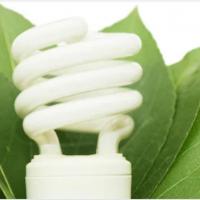Landscaping for Energy Efficiency
by Dan Eskelson on May 2, 2012
The proper placement of trees and shrubs around a home will have a significant impact on the energy required to heat and cool the structure. The few simple strategies outlined below will not only increase the property value of your home but also decrease energy costs. Techniques will vary slightly from region to region, but with knowledge of local conditions and some common sense, the immediate environment can be maximized for energy efficiency.
Planting shade trees to the south of your home is one of the most obvious energy-saving techniques; deciduous trees will block the hot summer sun but allow the winter sun to reach the house. In some areas, planting a deciduous shade tree to the southwest or west may be desired.
The U.S. Department of Energy estimates that the proper placement of only three trees will save the average household between $100 and $250 in annual energy costs. Be sure to account for the mature size of the tree - a common mistake is to plant too close to the house. Evergreen trees are useful as a winter windbreak; a double or staggered row of dense evergreens on the windward side of the home can save an average of 25% of energy costs, even more in windy areas. A South Dakota study found that windbreaks to the north, west, and east saved an average of 40% in fuel consumption. This technique is even more effective when smaller evergreens are included on both sides of the larger trees.
Plant your windbreak at a distance from your home equal to three to five times the height of the mature trees. Choose plant material that is appropriate for your region. To the south of your home, shade trees with high spreading crowns like oak, maple, and ash are best to block the summer sun. To the west, trees with lower crowns, or evergreens, can be used to shade the hot afternoon sun. Avoid the fast-growing trees like willow, poplar, and silver maple - these are short-lived and brittle. Smaller plants can also help reduce energy costs.
Vines are quick growing and will shade a south or west wall in one or two seasons. Vines can also be grown on a strategically placed trellis or on a pergola that covers the entire patio area. Shrubs planted near the house will help to shield from the cold wind of winter and the hot sun of summer. In very damp climates, however, keep plantings at a sufficient distance from the house to ensure adequate air circulation.
Groupings of shrubs can be used to "funnel" cool, nighttime breezes to open windows. If the incoming air is from low vents or screened windows and the outgoing air leaves the structure at a higher point, this "chimney effect" moves a lot of air and does an excellent cooling job. If you're in an area that cools off in the evening, give this a try. When designing your new landscape, or adding to an existing one, keep in mind that each region and each site has unique characteristics that must be considered to maximize energy efficiency. Study these characteristics in all seasons. For advice specific to your region, you might find some help at your County Extension Office.
Popular Articles
Three Places to Spend Money on the Exterior of Your Home
When you have the exterior of your home remodeled, you are investing, time, energy and convenience into the project and you want to make sure that...
99759 Views
Homemade Headboards-Make an Upholstered or Wooden Headboard
Homemade headboards can add a lot of personality to any bedroom. They can be coordinated with existing furniture and room decor or they can be the...
75597 Views
When to Use a Brush, Roller or Sponge Brush
Brushes are a good choice for painting trim and woodwork. They are also useful for cutting in the edges around the top and bottom edges and corners...
72484 Views
Creating a Cottage Kitchen with Bead Board
Kitchen decor can range from modern and bold to elegant and elaborate by using strategic kitchen pieces. One of the most popular decorating trends...
54019 Views
Gas Fireplace Diagnostics and Troubleshooting
Follow these steps for diagnosing and troubleshooting Gas Fireplaces repairs. For the average DIYer, this may seem intimidating, depending on the...
31207 Views
Latest Articles
How Much Does it Cost to Take a Bath?
Plumbers know that a bath may seem like a relaxing luxury, but the real cost extends far beyond your water bill. The average soak uses 35 to 50...
on Apr 8, 2025
10 Concrete Patio Ideas on a Budget
A concrete patio can be a game-changer for your outdoor space. It is durable, versatile, and can be customized to fit your style. But what if you...
on Mar 25, 2025
Tips for Creating a Stunning Personalized Photo on Canvas
Order the unique beauty of a personalized photo on canvas and bring your memories to life. With a customized photo on canvas, you can transform...
on Mar 7, 2025
Best Areas to Buy Property in Singapore for Long-Term Growth
Singapore's real estate market remains one of the most stable and lucrative in the world. With limited land supply, strong governmental...
on Feb 18, 2025
Troubleshooting Excess Water in Your HVAC Secondary Condensate Drain Pan
When maintaining your air conditioning system, it is easy to overlook the condensate drain pan - until excess water starts pooling in places where...
on Jan 12, 2025
Featured Articles
What Type of Licensed Contractor Should You Hire?
on Feb 28, 2017
Hire Contractors / Estimates

Looking for a specialty project? There are many types of contractors available for your home improvement needs. Finding the right type of...
Sponsored Articles
Best Areas to Buy Property in Singapore for Long-Term Growth
on Feb 18, 2025
Real Estate / Finance

Singapore's real estate market remains one of the most stable and lucrative in the world. With limited land supply, strong governmental...
Actions
Top Categories
- Garden / Landscaping / Patio — 264
- Kitchen / Bathrooms — 240
- Real Estate / Finance — 203
- Appliance / Repair — 186
- Interior Design / Decor — 184
- HVAC / Air Conditioning — 148
- Cleaning / Maintenance — 144
- Improvements / Remodeling — 131
- Plumbing / Basements — 118
- Floors / Tile / Hardwood — 116
- Doors / Garages — 113
- Safety / Security — 113
Articles Archive
More DIY Articles
7 Luxury Pool Ideas For Your Home with Liquid Limestone
Having a pool is a great way to add value to your home. It also provides a tranquil and cool outdoor space for lounging, entertaining, and even...
Installing a Kitchen Backsplash - Part I: Choosing Tile
A tile backsplash makes a beautiful focal point that adds interest and style to a kitchen while making cleanup easier. The abundance of tile...
How to Keep Your Bamboo Flooring Looking Fabulous
Not only is bamboo flooring an aesthetically pleasing addition to your home that will give you a lot of pleasure, but it also extremely durable and...
A 7-Day Plan to a Clean Entryway
Your front door entry is the first place in your home that is seen by other people, it is the first spot to welcome you home when you get there. It...
Light up the World - Lighting Architecture
A home can be beautified by its architecture – the doors, the halls, the pillars, and the arches; or by its decorations – the wallpapers, the...

